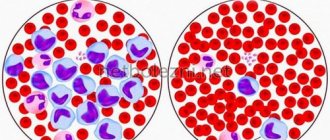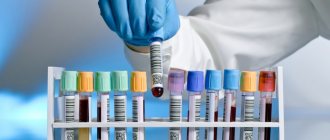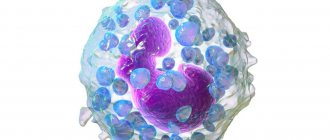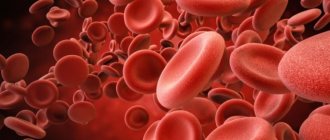From this article you will understand what this means if monocytes are low in an adult. Monocyte cells are the largest lymphocytes in the human body. This type of cell belongs to mononuclear leukocytes that do not contain granules in their structure.
The main function of monocytes is phagocytosis of pathogenic microorganisms, mutant and tumor cells, cleansing the wound from debris of dead leukocyte cells, etc.
Due to their pronounced phagocytic activity, monocytic cells are called “blood nurses.”
Elevated monocytes in the blood are observed in acute diseases of infectious origin, autoimmune pathologies, monoblastic and myelomonocytic leukemia, etc.
Reduced monocytes in the blood can be observed in a patient with shock conditions, after severe stress, with bone marrow lesions, severe infectious pathologies of a pyogenic nature, etc.
Monocytes are also reduced in patients undergoing long-term treatment with glucocorticoid hormones, immunosuppressive and cytostatic drugs.
What monocyte parameters are low in adults? What is monocytopenia?
Granulated monocytes in the blood
The body of an adult healthy person contains from three to eleven percent of monocytes from the number of leukocytes in the blood (1 ml of blood contains 450 of their cells). The minimum permissible reading of their quantity is 0.04x109/l. The standard level of monocytes varies slightly: to a greater extent depending on age, to a lesser extent - on national characteristics.
If the proportion of monocytes in the blood is less than 0.04x109/l, that is, less than 1% of the number of all leukocytes, this indicates monocytopenia.
Monocytopenia is a decrease in the level of monocytes in the blood relative to their standard number, which is observed in septic processes. With monocytopenia, regulatory mechanisms in cells are disrupted and, as a result, this contributes to:
- favorable conditions for the development of infections in tissues and their rapid transport through the cells of the body;
- transformation of the flora of the intestinal mucosa and respiratory tract into potentially dangerous;
- inflammation of small suppurations;
- loss of information by the body about pathological agents.
Symptoms and signs of low monocytes in adults

Monocytopenia is only a symptom of a certain disease
A deficiency in the number of monocytes cannot be determined by external signs or certain manifestations of disorders in the body. However, frequent illnesses, reduced immunity and slow regeneration of skin lesions may signal that there is a reason to consult a doctor with these symptoms and donate blood from a finger prick for analysis.
Causes of monocytopenia
A decrease in the number of monocytes is associated with problems in their synthesis, for which the bone marrow is responsible.
A reduced level of monocytes (monocytopenia) is favored by the following factors:
- various types of anemia;
- leukemia;
- acute infectious diseases (they are characterized by a general decrease in the number of leukocytes);
- pyogenic infections;
- diseases of the circulatory system;
- long-term purulent processes in the body;
- long-term use of hormonal drugs;
- recent operations;
- shock states of the body;
- stress, emotional instability;
- chemotherapy;
- chemical poisoning;
- consumption of glucocorticoid drugs;
- the period after childbirth during the first week;
- physical exhaustion of the body after long-term diets or an unbalanced diet.
Correction
Drug therapy
Monocytopenia itself may not require any treatment, such as in the case of chronic use of glucocorticoids. It is necessary to treat the underlying pathology, against which monocytopenia occurred. Since the etiology of a decrease in the number of monocytes is quite severe diseases, during treatment the patient should be in a hospital under the supervision of a doctor. The following methods of conservative therapy are used:
- Antibacterial therapy.
For purulent-septic processes, antibiotics from the group of penicillins, cephalosporins or aminoglycosides are prescribed. For rickettsial infections and typhoid fever, preference is given to fluoroquinolones, tetracyclines or macrolides. - Chemotherapy.
In order to eliminate the tumor clone and achieve remission in HCL, nucleoside analogues are used. Cytostatic drugs are used in patients with aplastic anemia. - Hematopoiesis stimulants.
To activate hematopoietic processes, AA patients are prescribed colony-stimulating factors, stimulators of platelet and erythrocyte formation. - Genetically engineered biological products.
Also, monoclonal antibodies against the CD 52 lymphocyte antigen and antithymocyte globulin obtained by immunizing animals with human lymphocytes are very effective for the treatment of AA. - Blood transfusions.
Patients with hematological diseases are often prescribed transfusions of whole blood or its components - red blood cells, platelet concentrate.
Surgery
For patients with abscesses and phlegmon, the purulent focus is opened and drained. In cases of severe splenomegaly, the spleen is removed. Since after splenectomy the risk of infection with certain bacterial infections increases, people who have undergone this operation must be vaccinated against pneumococcus, meningococcus, and Haemophilus influenzae.
Hematopoietic stem cell transplantation allows for complete cure for AA and HCL. However, given the risk of developing a life-threatening graft-versus-host reaction, this operation is not prescribed for all patients, but only for clear indications. Bone marrow transplantation is also performed in patients with GATA 2 deficiency.
How to detect low monocyte levels
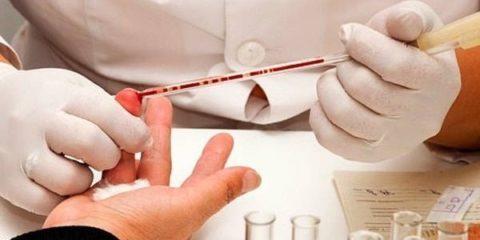
Laboratory tests can detect monocytopenia
To detect a low level of monocytes, it is necessary to take a general blood test from a finger prick. It can be prescribed upon request due to symptoms of monocyte deficiency, as well as for any abnormalities in the body.
You can decipher the test results yourself by comparing the indicators in the monocyte line on the coupon with the standard indicators, or by consulting a doctor. The most accurate result will be given by the doctor when he finds out possible concomitant factors and characteristics of your body. In some cases, the doctor may prescribe additional medical tests to more accurately determine the source of the disorder.
Treatment for low monocytes in adults
A low level of monocytes in the blood cannot be independently regulated: it will probably not be possible to raise their level, even if you yourself were able to suggest a possible cause for this condition.
If monocytopenia is detected, the doctor must establish a list of potential root causes and take measures to eliminate them, as well as normalize the body’s functioning. Sometimes, especially if the reason lies in the exhaustion of the body after an unbalanced diet, it is enough to reconsider the diet to regulate the level of monocytes. In some cases, drug treatment is necessary if the cause of monocytopenia is acquired diseases. If problems with the circulatory system, as well as cancer, are identified, it is necessary to understand that the process of normalizing the level of monocytes will take a long time.
In addition to taking into account the doctor’s recommendations, you need to remember the basics of a healthy lifestyle and adhere to a complete, balanced diet in order to quickly level your blood counts to normal values.
All changes to normalize indicators must be carried out under regular medical supervision and testing!
What does this mean if an adult has low monocytes?
In adult patients, the causes of a decrease in monocytes (development of monocytopenia) may be:
- severe stress;
- treatment with immunosuppressive drugs, glucocorticoids, cytostatic drugs;
- aplastic anemia and other diseases accompanied by bone marrow lesions;
- hairy cell leukemia;
- postpartum conditions (especially during complicated childbirth);
- conditions after surgical interventions;
- severe pyogenic infections.
Monocytes are often moderately reduced in an adult after severe physical fatigue.
The reasons for a decrease in monocytes in a child are similar.
The most common reasons for an increase in the level of monocytic cells may be infectious pathologies, various collagenoses, lymphogranulomatosis, long-term use of beta-lactam drugs, etc.
Threat with monocytopenia

Monocytopenia is a symptom that should not be ignored
Decreased monocyte counts may be a natural occurrence and not something to worry about, only in pregnant women. However, not always: even pregnant women need to constantly make sure that there are no deviations under the supervision of a doctor.
Maintaining monocyte counts within normal limits is essential. They are protectors that destroy foreign pathological agents, and also fight various infections, fungal diseases and help fight malignant cancer tumors.
In addition to the individual duties of monocytes, they, like other blood cells, perform the following functions:
- Destruction and prevention of the development of potentially dangerous pathogenic bacteria.
- Regulation of the body's immune responses to inflammatory processes.
- Control over protein production.
- Destruction of obsolete, damaged and defective cells from the body.
- Creating a favorable environment for tissue regeneration after external and internal damage.
The role played by monocytes is very important in the overall functioning of the body, so it responds negatively to any decrease in their number.
The role of monocytes in the body
Monocyte cells belong to the group of the most active phagocytes. They are capable of:
- participate in the formation of the body’s immune responses;
- act as antigen-presenting cells, contribute to the maintenance of immune memory;
- produce various biologically active substances;
- actively multiply in the inflammatory focus, maintaining the intensity of the body’s immune response;
- actively capture and digest pathogenic microorganisms, tumor and mutant cells of the body’s own tissue and organ structures, debris of cells killed during the immune response, etc.;
- phagocytose cells of damaged tissues at the site of the inflammatory reaction;
- promote cleansing of wound surfaces and promote their speedy regeneration;
- participate in the production of blood clotting factors.
A specific feature of monocytic cells is their pronounced ability to independently migrate to inflammatory foci. It should also be noted that monocytic cells do not die after contact with pathogenic microorganisms, but continue to participate in the processes of phagocytosis.
Main article: All about monocytes in the blood and their norm in women and men
Prevention

A balanced diet is a good way to prevent monocytopenia.
To prevent monocytopenia, it is recommended to visit a doctor for blood tests at least annually.
You can help maintain an optimal monocyte count by simply improving your balanced diet. Including buckwheat or oatmeal, onions and garlic, greens (especially celery), nuts, currants and blueberries, as well as apricots in your daily diet will help maintain blood in good condition. Homemade decoctions also perform this function: rose hips, wormwood leaves and honey.
It is strictly prohibited to take medications on your own in case of deficiency, but it is within your power to monitor a stable emotional state and provide the body with a complete nutritious diet.
Diagnostics
Due to the wide range of etiological factors of monocytopenia, its detection in a blood test requires contacting a general practitioner. At the appointment, the patient is interviewed and anamnestic data is collected. It is clarified whether the patient is registered with a dispensary and whether he is taking hormonal medications. A careful physical examination is performed to identify symptoms that can help narrow the differential diagnosis of causes of monocytopenia.
Body temperature, blood pressure, and pulse are measured. The skin and mucous membranes are examined for pallor and the presence of hemorrhages (petechiae, ecchymosis). Palpation of peripheral lymph nodes, liver, and spleen is performed. Additional research methods are also prescribed:
- General blood analysis.
The hemogram may show an increase in ESR, leukocytosis (with infections), or, conversely, anemia, thrombocytopenia, leukopenia. Microscopy of a blood smear in patients with septic processes reveals morphological changes in leukocytes - toxigenic granularity of neutrophils, vacuolization of the cytoplasm. A characteristic sign of ON is considered to be “hairy lymphocytes” with villous processes. - Blood chemistry.
When conducting biochemical tests, an increase in the content of C-reactive protein and lactate dehydrogenase is detected. - Microbiological research.
In order to identify the infectious pathogen and prescribe targeted antibiotic therapy, bacterial culture is performed to determine sensitivity to antibiotics. - Immunological studies.
Patients with suspected generalization of purulent infections, i.e. development of sepsis, an analysis for procalcitonin and presepsin is required. - Flow cytometry.
This diagnostic method makes it possible to determine the immunophenotype of tumor lymphocytes in patients with HCL by detecting the expression of various markers (CD19, CD20, CD22). Also, using flow cytometry in patients with aplastic anemia (AA), it is possible to identify immunophenotypic signs of dysmyelosis and determine the presence of a PNH clone. - Histological studies.
Trephine biopsy is required to confirm ON and AA. In ONL, bone marrow aspirate shows diffuse infiltration of lymphoid cells with an irregularly shaped nucleus and wide cytoplasm. The following picture is typical for AA - a small number of hematopoietic cells, intertrabecular spaces filled with fat. - Genetic research.
The GATA 2 gene mutation is determined using PCR analysis, sequencing and karyotyping. - Ultrasound.
Ultrasound of the abdominal organs in patients with hematological diseases reveals an increase in the size of the liver and spleen.

Blood collection for laboratory testing
